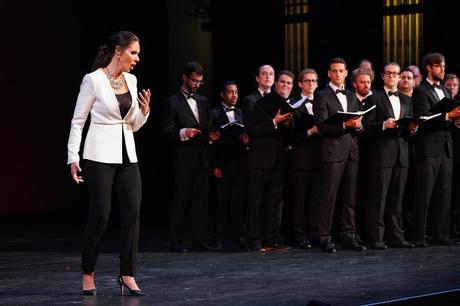by Paul J. Pelkonen

Warrior woman: Tamara Mumford as Tancredi confronts the chorus.
Photo by Steven Pisano for Teatro Nuovo courtesy Unison Media.
For this first festival, held over two weekends, the centerpiece was Tancredi, the 1817 Gioachino Rossini masterpiece. Tancredi launched Rossini as a radical new voice of opera on the Italian peninsula. Although beset with a plot that twists and turns through the hoariest of opera seria clichés, one clearly sees and hears that Rossini was pushing his way toward something better: a new kind of opera that would leave the baroque style behind and forge something that would in the 19th century, start to redefine opera as an Italian stage art.
The plot of Tancredi is taken from a Voltaire play, and tells of a battle between Christian knights and mustache-twirling Saracens for possession of the city of Syracuse in the years following the Crusades. Tancredi himself is a trouser role, taken here by the marvelous Tamara Mumford, a star turn that requires tremendous stage presence and considerable vocal firepower. It is written for that most elusive of voice-types: the rich mezzo-soprano with low alto notes that can also sing fiery ornamentation. Maybe this is why the opera has been largely forgotten even as the bel canto style has returned to vogue. '
Stalking the stage in a tight pair of heels and a nipped white jacket, Ms. Mumford brought a leonine and very masculine presence to Friday night's performance. She immersed herself thoroughly in Tancredi's heartbreak and crisis, delivering the role with a burning seriousness. (He thinks his wife has betrayed him, and the bulk of the opera is about righting that wrong and fighting battles.) The choice (in this performance) to use the happy "alternate" ending where Tancredi is not killed felt like a kind of reward for the patient audience.
Soprano Amanda Woodbury showed why she is a star on the rise, singing the thankless role of Tancredi's very put-upon wife Amenaide with a secure top and impressive control in the upper reaches of her voice. This is a long and complicated role with difficult arias and a wide emotional range, and the singer met all of its demands. She provided the biggest vocal fireworks of the night, rolling out clouds of creamy tone in the slow cavatina sections and then making big notes burst in the cabaletti.
The third impressive performance was tenor Santiago Ballerini, whose pleasing technique and ringing tenor voice made one struggle to remember that as Amenaide's father, he was one of the opera's villains. The other heavy was played by baritone Leo Radosavljevic, who (it was announced) was facing allergy issues. Those vocal difficulties did not prevent him from getting killed by Tancredi halfway through the second act in an offstage gladiatorial combat that may have inspired Wagner's Lohengrin.
It is a pity then that these fine singers were couched in such a pedestrian presentation. Mr. Crutchfield has made much of his intent: to present Rossini's operas as Rossini himself would have staged them, but this spectacle at SUNY had the feel of an under-rehearsed college play. Singers tromped on and off the vast, featureless acting surface, which lacked even interesting lighting changes to engage the eye. With everyone in evening-wear, it was a challenge to keep the characters and their allegiances straight.
Mr. Crutchfield led from the harpsichord with violinist Jakob Lehmann as concertmaster. His ensemble gathered at the lip of the stage, with instruments (and prompter) threatening to block the view of patrons in the most expensive seats. (A swathe of those seats remained empty too, probably the cost of competing with nearby Caramoor for the arts dollars of this part of Westchester.) The male chorus, taut and on point moved phalanx-like about the stage as if looking for some Saracens to battle--except for the scene in Act II where they were the Saracens.

